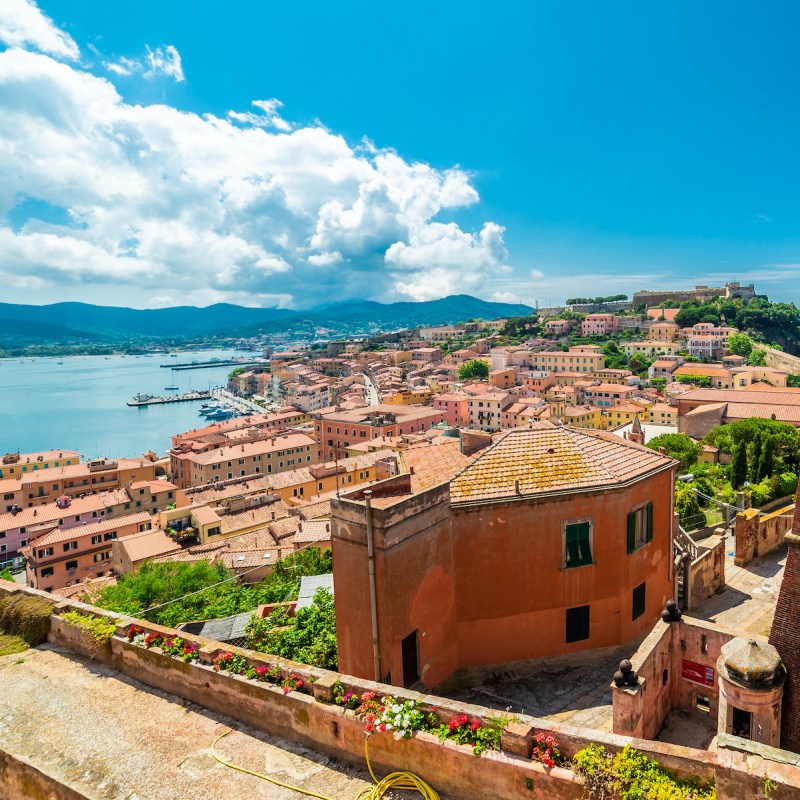
When thinking about Italian islands, names like Sardinia, Sicily, or Capri will probably spring to mind first. Whilst these are sitting in the Mediterranean Sea, we will introduce you to an island in the Tyrrhenian Sea off the coast of Tuscany. Elba, or Isola d’Elba in Italian, is the largest of seven islands that form the Tuscan archipelago, located just 10 miles east of the Tuscan town of Piombino, which is also the departure port for the ferry, the only way to travel to Elba. There is a small airport on the island, but it is not frequented by popular airlines.
Videos by TravelAwaits
Portoferraio is the island’s capital, the largest city, and the port where the ferries from Piombino arrive. Before embarking on your trip to Elba, you should take some time to explore Piombino with its historical center, marina, and terrace jutting out over the sea.
The best time to visit Elba is from April to October when Italians and other nationals – predominantly Europeans – come to enjoy an island that is so diverse and is growing more appreciated. Elba’s name is probably best known because it was here that Emperor Napoleon was exiled in 1814. Apparently, he didn’t like the island very much. Under the circumstances, this is hardly surprising, but his exile lasted only 9 months. Today’s visitors, however, will love it because there is so much to do and see. The interior is rugged and crisscrossed with many paths for avid hikers and walkers. Beach lovers find their paradise on one of the approximately 80 beaches and coves. Divers and snorkelers can explore the crystal clear water and the sea life of the coasts.
Fans of history can visit the home of Napoleon, the museums, and can enjoy the fine food and wines of Elba. A last word to the legacy of the emperor: he wasn’t idle during his exile. He worked on improvements, foremost the creation of the internal road network. This is indeed very convenient because the ferry carries cars during the summer, meaning that you can explore the island in a vehicle. That said, the interior roads are steep and winding.

1. Exploring Portoferraio
The name reflects the island’s past when iron ore was mined, milled, and exported from here; this industry brought wealth to Elba. Portoferraio greets you with a massive fortress, called Medici Fortress, and a lovely old town that is prettier than the industrial port area. Visit the Linguella Tower Villa dei Mulini, Napoleon’s residence during his exile on Elba. The villa is today a national museum.
It’s not only Napoleon who left his traces; the Romans did so too. Remains of a Roman villa can be visited near the Martello Tower. Despite his rather short sojourn on Elba, Napoleon treated himself to a summer residence a short distance from Portoferraio called Villa San Martino. The magnificent neoclassical architecture of the building is worth the little side trip from the capital.
There are also various festivals during the year, even more so as it is the 201st anniversary of Napoleon’s death. Depending on your tastes and interests, you might want to plan your stay around these dates.
If you like seafood, a great place to eat in Portoferraio is Pizzeria 2001.

2. Climbing Mount Cappane
At 3,343 feet, Mount Cappane is the highest elevation on the island. Choose a clear day and set off early in the morning to ascend the peak for a spectacular view over Elba and the entire archipelago. There are two ways to get to the top: if you are a keen and fit hiker, you can do it on foot. The path leads through a thick chestnut tree forest and at the top awaits a facility with a bar to catch your breath and freshen up. The trek takes about 3 hours.
More fun, in my opinion, is to use the cable car because it is such a tiny thing. But you better not have fear of heights, because it’s just a cage – open on all sides – that only carries a maximum of two adults. The cable car runs from early spring to the end of September. The departure station is to be found between the villages of Poggio and Marciano, and the ride takes 20 minutes. There is a big parking lot at the station where you can leave your car and also a bar and pizzeria.

3. Enjoying The Beaches Of Porto Azzurro
If hiking in the mountains isn’t your thing and you have come to Elba for the beaches and water sports, you’ll find no shortage of either. The Elba beaches are partially sandy and partially pebbles, so there is something for every taste.
Porto Azzurro is a charming seaside town, dominated by the massive 17th-century San Giacomo Fort that stands on the promontory. Located in the southeast part of the island, Porto Azzurro shed its past as a civil prison when tourism started to develop and is now one of the most visited places on Elba. Not only is the pretty village full of narrow streets of quaint shops, but it’s also near three fabulous beaches. They are Terranera Beach, with its pool of an emerald green sulfur lake and shiny black sand, Reale Beach, and Barbarossa Beach. The latter is a mixture of sand and shingle, but very smooth and dark in color. The beach can be reached from Porto Azzurro by a short scenic pathway that follows the lower wall of San Giacomo Fort. There is also a hotel, and on all the beaches you will find beach clubs and restaurants that provide you with sun loungers.
If you prefer fine, golden sand, you have to head to the southwest side of the island, to Marina di Campo and the famous Fetovaia Beach. Blue water, granite cliffs, and lots of green vegetation contrast beautifully with the color of the sand.

4. Visiting Capoliveri
Capoliveri is an enticing, larger town on the south coast of Elba. Its special attraction lies in the fact that it is a medieval town located on a hill with a great view over the south. Squares, narrow streets, and plenty of steps, often running below archways and lined with balconies bursting with flowers, give this town a special charm. Capoliveri was long connected to the now-defunct Mines of Calamita, which are a popular tourist attraction to explore. During your visit, you can enter into the Ginevro mine with a guided tour and learn all about the hard work of the miners in the Museum of the Workshop. Capoliveri celebrates its mining past with a festival at the end of May.
Not only is the history of Capoliveri captivating, but the beaches are a special attraction as well. Lacona Beach, nearly a mile of golden sand and the second-longest beach on Elba, is the only beach that still has sand dunes left. It is popular with young people and has bars, restaurants, and beach clubs that provide amenities. There are also parts that are free and where you can just spread your towel.

5. Diving And Snorkeling
Whether you are an experienced scuba diver or prefer to stick to snorkeling, there are over 30 sites on Elba where you can carry out this activity. They are mostly to be found on the northern side. In the southwest, one of the most exciting experiences is diving the wreck off of Pomonte. In 1972, an Italian cargo ship by the name of Elviscot was shipwrecked on Ogliers’ rock and sank, now lying on the bottom of the sea completely covered with marine organisms and a habitat for fish. The bridge and engine room of the ship can safely be dived.
Capo di Colvo is for experienced divers, while Punta della Madonna takes you down a sea wall and nearer the surface to come to the statue of a Madonna. For more information and alternative sites, visit the Ondasub Diving Center in Marina di Campo.

6. The Aquarium
If you want to see the sea life but neither scuba dive nor are fond of snorkeling, you can visit the popular aquarium in Marina di Campo. Over 50,000 visitors per year find their way to what is considered one of the most complete aquariums of the Mediterranean. 80 tanks house over 1,150 different species of marine life.
7. Moncione Mill
Another interesting look into the island’s past is to be had with a visit to the Moncione Mill. It is one of the largest and most beautiful water mills on Elba, deep in the countryside and standing on a promontory overlooking the sea and facing Montecristo and Pianosa. The mill was enlarged and made more productive in 1880 until production ceased in 1910. The wheat was transported up to the mill on donkeys’ backs, and the flour came back down the same way.
The building is still standing and can be visited, as can the millpond and some of the cogs.
Pro Tips
- In the summer months of July and August, it can get very crowded because the Italians enjoy their summer break.
- A lot of walking is required, either in the countryside or the cities, so make sure you are reasonably fit and have good shoes.
For more on Italy, check out these articles:

